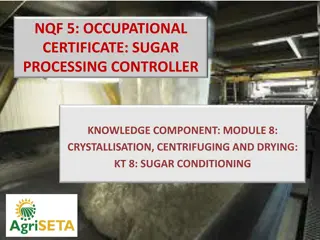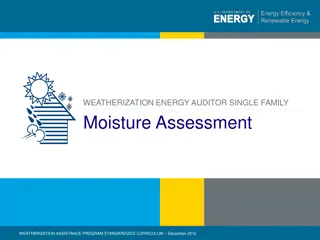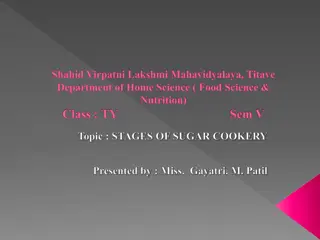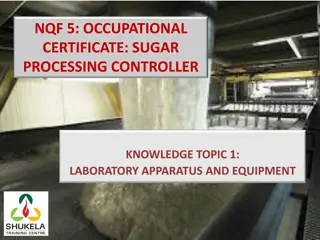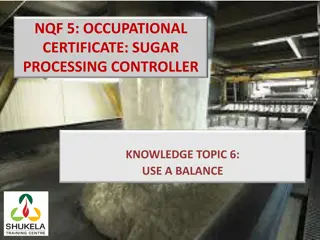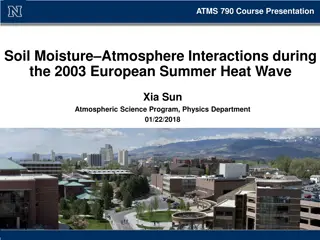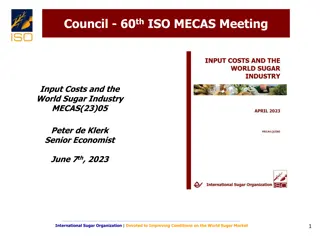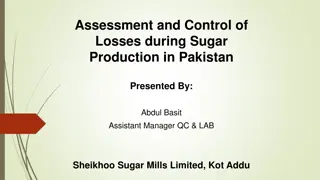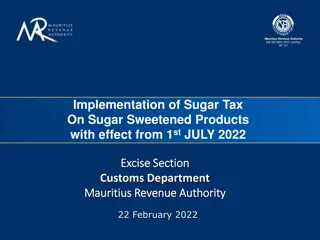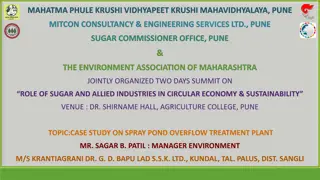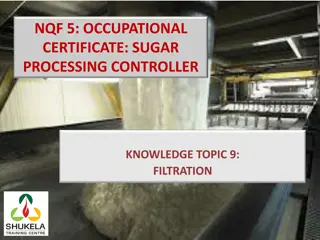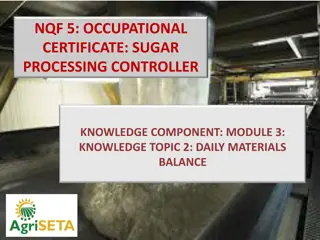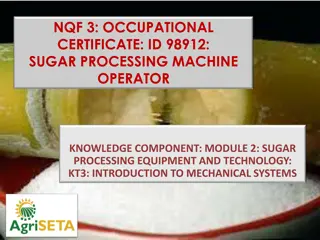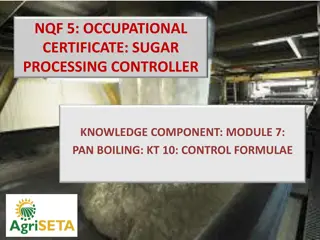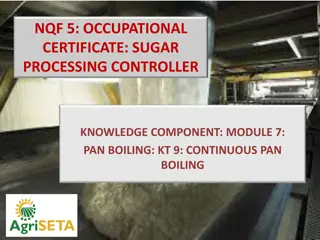Understanding Moisture Measurement in Sugar Processing
This content delves into the importance of moisture measurement in sugar processing, specifically focusing on the drying process. It explains how moisture percentage is crucial for various calculations and efficiency assessments in the sugar production industry. The equipment and procedures used for analyzing moisture content are detailed, providing valuable insights into this essential aspect of sugar processing.
Download Presentation

Please find below an Image/Link to download the presentation.
The content on the website is provided AS IS for your information and personal use only. It may not be sold, licensed, or shared on other websites without obtaining consent from the author. Download presentation by click this link. If you encounter any issues during the download, it is possible that the publisher has removed the file from their server.
E N D
Presentation Transcript
NQF 5: OCCUPATIONAL CERTIFICATE: SUGAR PROCESSING CONTROLLER KNOWLEDGE TOPIC 10: DRYING
INTRODUCTION (1) Drying is the process whereby moisture is removed from a substance by heating. This is done so that the moisture % of a substance can be determined.
INTRODUCTION (2) The moisture % is used for various purposes. Moisture % cane is used in the DAC calculations for cane payment. Moisture % bagasse is used to measure the efficiency of the dewatering process i.e. how well the mills are working. Moisture % filter cake is used as a guide to the efficiency of the rotary vacuum filters. Moisture % sugar is used as a measure of the efficiency of the sugar dryer. Dry solids % molasses is an alternative method of measuring the total soluble solids content of molasses and is more accurate than the refractometer brix determination. Definition of DAC: Direct Analysis of Cane system used for cane payments to cane growers
INTRODUCTION (3) The flow chart below shows the sugar production process where some of these measurements are needed:
EQUIPMENT To measure moisture % we need to use an oven. There are three types of ovens in use in a mill laboratory. They are: The Spencer type oven (Labotec or Dietert) Moisture oven with circulating fan Vacuum oven
SPENCER TYPE OVEN In a Spencer type oven a fan blows hot air from the top through the sample which is placed in a tray. The tray has a screen at the bottom which allows the hot moist air to pass through. The Spencer oven is used for prepared cane or bagasse.
PROCEDURE FOR ANALYSING MOISTURE The moisture tray must be thoroughly cleaned with a brush and preheated in the oven for five minutes. The tray must be preheated because after the sample is dried it must be massed hot to prevent reabsorption of moisture. It is massed hot because the tray is too big to fit in a desiccator to cool. The tray is massed empty, the sample is added and the mass of the tray with sample is recorded. The tray is then placed in the oven for 60 minutes at 105 C. At the end of the time period the tray must be removed and massed hot. This must be done immediately, not 5 or 10 minutes later or the sample will have reabsorbed moisture. Care must be taken that the fan is not running while the tray is removed or small particles might blow away, giving an incorrect result.
CALCULATION Mass of empty tray = A grams Mass of tray and wet sample = B grams Mass of tray and dry sample = C grams Moisture % = ? ? ? ? 100 or ???? ?? ???????? ???? ?? ??? ?????? 100 Record the answer correct to two decimal places. =
MOISTURE OVEN The moisture oven is used for sugar and filter cake moisture. The oven has a circulating fan to ensure that the temperature inside the oven is uniform and that there are no hot spots. The moisture % sugar analysis is critical and the mass and timing must be done accurately.
PROCEDURE FOR USING THE MOISTURE OVEN (1) Dry a clean moisture dish for 1 hr at 105 C in the moisture oven. Cool in a desiccator. Weigh the clean and dry moisture dish and lid to the accuracy required by the particular analysis. Add the amount of sample required. Replace the lid immediately and reweigh the moisture dish containing the sample. Place the dish in the oven. Remove the lid, invert the lid and place the moisture dish inside the lid.
PROCEDURE FOR USING THE MOISTURE OVEN (2) Dry for 3 hours as required at 105 C (sugar) or 4 hours at 130 C (filter cake) Using tongs replace the lid on the dish and remove from the oven. Place in a desiccator and allow to cool to ambient temperature for 1 hour. Weigh the dish, lid and dry sample to the precision required. Moisture % = ???? ?? ???????? ???? ?? ?????? 100 Note: When placing samples into a moisture oven, start placing the samples on the top shelf and work down towards the bottom shelf. When removing samples from a moisture oven start at the bottom shelf and work upwards towards the top shelf. This reduces the risk of one sample spill contaminating several other samples.


